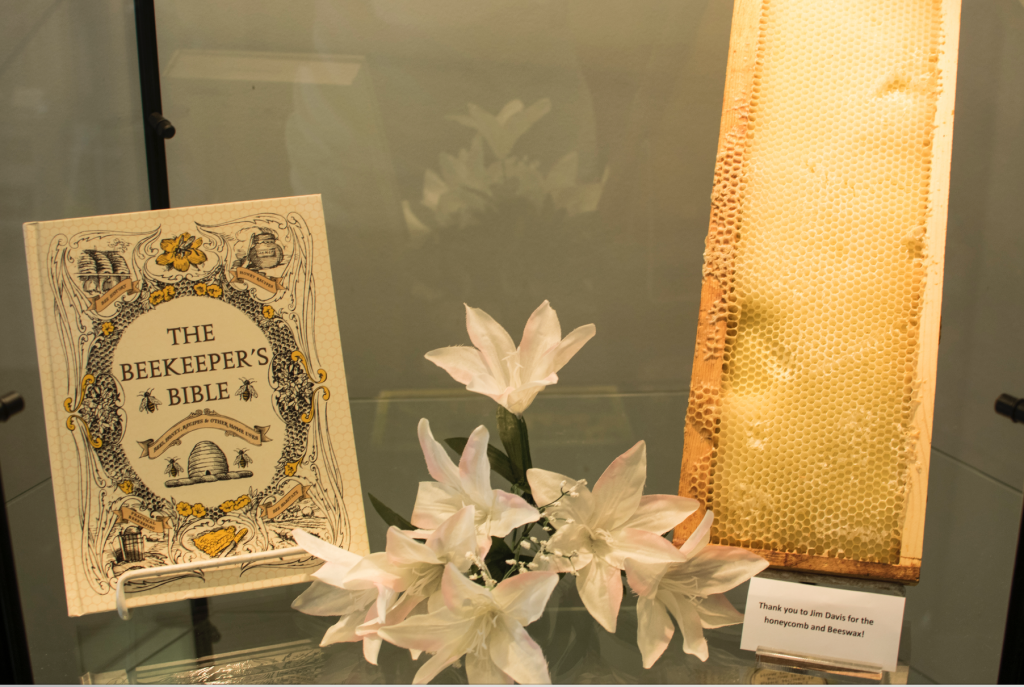The U.S. Agriculture Department reports waning rates of infamous bee-killer Colony Collapse Disorder since 2010, but bees are still far from safe.
The UI Sciences Library has teamed up with local beekeepers to promote pollinator-friendly practices this summer with a “Beekeeping 101” exhibit and event.
The exhibit features donated beekeeping equipment in glass cases near the library’s front entrance. Informational signs and some of the library’s books on bees are on display as well.
The library put the exhibit together to inform visitors about what bees do for people.
“People typically think of bees just for honey, and I don’t think they always realize how important they are as pollinators,” said Laurie Neuerburg, a references and outreach librarian who curated the exhibit with Sciences Library coworkers.
Crops such as almonds, berries, and beans — as well as many wild flowering plants — depend on or benefit from cross-pollination by bees. These species are threatened by declining wild and domestic bee populations.
“My wife twisted my arm in spite of my telling her, ‘You know they sting, right?’ ” said local beekeeper Jim Davis, who has kept bees for nine years, mainly to pollinate the prairie, garden, and fruit trees on his property.
Davis, the secretary of the East Central Iowa Beekeepers Association, donated such items as honeycomb, beeswax, and homemade Mason Houses — habitat for pupa of the non-stinging Mason bee species — to the exhibit.
“I like to stress more and more the importance of all the other bees, as well as honeybees,” he said.
RELATED: Iowa Honey Bee day celebrates the importance of bees
Approximately 300 to 400 species of bees are found in Iowa, many of them better pollinators than honeybees. While these species may not receive the same credit and attention as the honeybee, Davis said, they are threatened by the same hazards and benefit from efforts to reduce those threats.
Besides Colony Collapse Disorder, which still kills around 30 percent of hives a year on average, the USDA cites pathogens, parasites, poor nutrition, and pesticides as major causes of population loss.
Davis said people who want to help the bees can do so by planting pollinator-friendly plants and reducing pesticide use on lawns.
Jeremy Richardson, a UI engineer in the Biology Department, donated his beekeeping suit, among other items. He also keeps bees to pollinate his orchard.
His trees have produced noticeably more fruit since he got his bees four years ago, he said, noting that his apple trees now bear fruit every year instead of every other. Other trees did not bear fruit at all before the bees.
“Whatever it was, coincidence or not, when the bees came, so did the kiwi,” he said.
There are many different bee killers, he said, from warm winters to animal predators, but the worst he had experienced was the wax moth, which once destroyed one of his hives.
What Richardson most wants people to get out of “Beekeeping 101” is that bees are necessary, not vicious insects. He said if more people embraced them, there would be a better chance of saving bee populations.
Young people today do not understand just how much of the bee population has been lost, he said.
“Bees used to be everywhere, and now you can walk barefoot and never step on them,” he said. “I miss them.”
Richardson said he is encouraged that more people seem to be becoming interested in bees recently.







